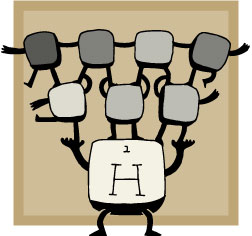Blogging the Periodic Table

In some sense, what you might have suspected from the first day of high-school chemistry is true: The periodic table is a colossal waste of time. Nine out of every 10 atoms in the universe are hydrogen, the first element and the major constituent of stars. The other 10 percent of all atoms are helium. That's already 100 percent. The rest of the periodic table, Elements 3 through 118, lithium through ununoctium, barely register on a cosmic scale. The rest of the universe, you and I included, is a rounding error.
The periodic table is a letdown in another sense, too: Given all its columns and rows, it looks like it should contain dozens of different types of elements, but there are really only a few. Most of the table's surface is therefore redundant. Gases like oxygen and nitrogen, semiconductors like carbon and silicon, amorphous powders like sulfur—they tend to cluster on the right, especially in the top quadrant. The variety there is dazzling but quickly fades as you move down or to the left. In fact, three-quarters of the elements on the table are metals. If you built a model of our castle-shaped periodic table by using a brick of each (solid) element, most of the facade would be a rather dull gray.
Still, even though the elements in the top right quadrant are outnumbered—both in terms of the sheer population of atoms in the universe and the spots occupied on the periodic table—they also make up much of our humble home planet. That's especially true in the top layers of the crust that support life. Your body needs two dozen elements to function, and most are from the top right quadrant.
So in that sense, learning about the diversity of the periodic table is not a waste of time (you had to see that coming). Indeed, one of the periodic table's most intriguing mysteries is where that diversity of elements came from. For a long time, scientists assumed the elements had just appeared ex nihilo from the Big Bang. They have since realized that the Big Bang created little but hydrogen and some helium. Instead, the nuclear furnaces operating inside stars like our sun create most elements, by fusing smaller atoms together. Most stars just fuse hydrogen into helium, but larger stars can fuse helium into other elements. Still larger stars in turn fuse those elements into slightly bigger ones, and so on.
Stars create the largest elements (up to the largest natural one, uranium, Element 92) in massive supernova explosions. Supernovae also spread elements once concentrated in stars across galaxies and can trigger the formation of planets and solar systems. So ultimately, the entire periodic table is contained inside hydrogen, since it serves as the building block for everything else.
Over the years, humans have managed to incorporate nearly every element, light and weighty, common and obscure, into our daily lives. And given how small atoms are and how many of them there are all around us, it's almost certain that your body has at least brushed against an atom of every single natural element on the periodic table. A typical piece of modern electronics contains dozens and dozens of elements, and even the heaviest natural element, uranium, appears in most granite countertops. A few smaller elements (e.g., technetium, Element 43) once appeared in nature but do not any more—they were fragile and disintegrated long ago. But atmospheric nuclear bomb tests in the 1950s created new versions of these disappeared elements, and traces of many still linger in the air. What was the main element in those nuclear bombs, the progenitor of all those elements? Hydrogen, naturally.